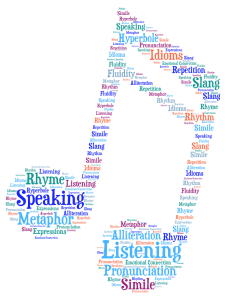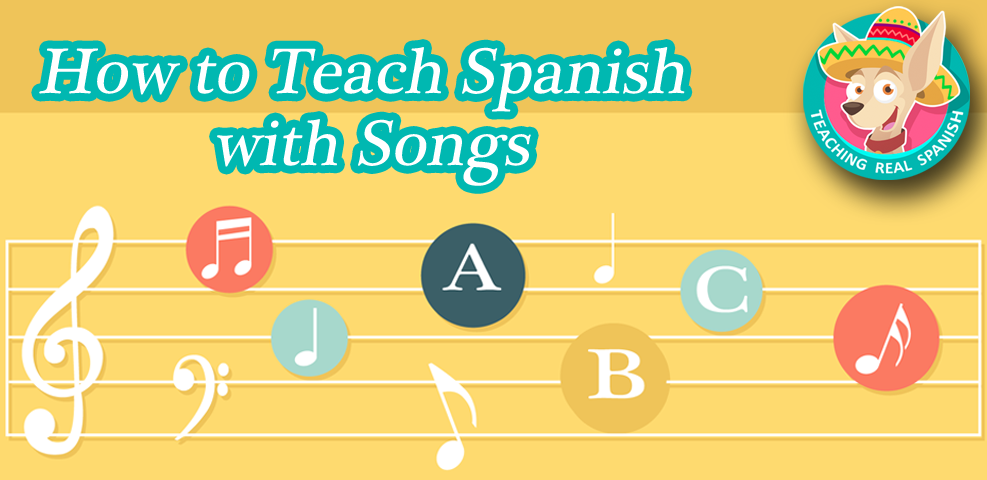 Music is a beautiful form of artistic expression. It can reach deep inside of us and make us feel many different things. It can also be a great tool to teach Spanish to your students!
Music is a beautiful form of artistic expression. It can reach deep inside of us and make us feel many different things. It can also be a great tool to teach Spanish to your students!
Songs contain so many elements that are useful for learners to practice.
In this post, I’m going to talk about:
- Why music is a great learning tool
- How to select a good song
- How to structure your lesson plan
- 4 strategies to adapt the song to your students’ level
WHY MUSIC IS A GREAT LEARNING TOOL
Students learn best when they’re not nervous about what they’re doing. If you can help your students relax, it’ll be easier for them to learn what you’re trying to teach. Dr. Stephen Krashen calls this lowering the affective filter.
Music is relaxing. Studies show that music is so soothing that it can actually lower blood pressure, your heart rate, and levels of certain stress hormones.
In addition to relaxing students, music holds their attention. People love listening to music in their native language, and if it’s presented in the right way, they’ll love listening to music in Spanish as well. A lesson plan built around a song can be a great way to energize your students or boost their motivation.
The rhythms in music are also a great mnemonic device to help students remember things. I’m sure you can think of at least one song or poem from your childhood that you’ve still got memorized.
PICKING THE RIGHT SONG
Your first step is to figure out what you’re trying to do. Some options might be:
- Training your students’ ears
- Practicing pronunciation
- Identify verb forms
- Acquiring new vocabulary
- Examining cultural topics
- Reinforcing grammar
- Livening up the class morale
Once you’ve identified your purpose, you’ll need to start flipping through your iTunes or get on to Google. Try searching for exactly what you’re looking for “songs in Spanish to teach simple past” for example, and see if you get any good results.
One resource is this site: http://www.songsforteaching.com/spanishsongs.htm which has a good selection of songs for different topics.
The easiest way to always have songs to use is to listen to plenty of music in Spanish yourself! More often than not, I’m listening to the radio or something and I think, “Wow… this song is filled with commands. It would be perfect for teaching that!” and I text or email myself a note right then.
Some tips for picking the right song:
- Don’t pick something too fast. Spanish already sounds fast enough because of encadenamiento – you don’t want to scare your learners.
- Don’t worry about the song not being fun enough; if you’re excited, your students will be excited.
- Check for fowl language depending on the age of your students
STRUCTURING YOUR LESSON PLAN
You can build your lesson around a song the same way you would any other text. One important thing to remember is to build up the song before listening to it.
First, I suggest some sort of attention grabber. My favorite is hangman with the title of the song. It is quick and easy, and it builds buy-in. This should take about 5-minutes.
Second, you’ll need a lead-in that will take about 20minutes.
- Create the context: if the song is social or cultural in nature, explain to your students what was going on in the world at the time. Use lots of images!
- Review the grammar point you’re asking the students to listen for
- Practice pronunciation of key words you want students to pick out
- Provide pictures of the new vocabulary
After your lead-in, I suggest listening to the song once before handing out the lyrics to your students. Explain that the point is not to understand the song (yet), but rather to prime them. Ask some simple questions after the first listen. Is the song happy or sad? Do you recognize the artist? Did you recognize any words? (3-5minutes)
After the first listen-through comes your main activity. This will require about 20 minutes as you’re going to listen to the song several times. A simple gap fill is great, but you’ll really want to adapt the activity to your students level. For my 4 ideas on how to do that, skip to the next section.
Finally, you’ll want to quickly review the song and anything your students learned during the lesson.
4 STRATEGIES FOR YOUR MAIN ACTIVITY
These are just four of the many different activities you can plan for a song (or any kind of text). I’ve ordered them from what will be easiest to most difficult for your learners.
- Lyrical Mix-Up: A great activity is to give the students a copy of the lyrics that has been cut into large parts such as stanzas or 2 or 3 line chunks. As the students listen to the song, they simply need to put the lyrics back into the correct order.
- A or B: Take a copy of the lyrics and select 5-10 target words. Find words that sound similar or words which students are likely to confuse. Insert them into the lyrics. As the students listen, they have to choose if they heard option A or B. This is much easier than completely removing the word from the lyrics, yet it is still challenging and educational.
- Cloze with Clues: Remove 5-10 target words and replace them with a blank. Next to the blank, provide a clue to help guide students to the correct answer. For example, “past form of walk” or “starts with the letter s.” This is a great stepping stone to a full cloze activity.
- Cloze Lyrics: Remove 5-10 target words from the lyrics. Listen to the song 2 or 3 times and ask students to fill in the missing words. A standard cloze activity is actually quite advanced when it comes to listening to a song written for native speakers. I suggest reserving this for advanced students or for a challenging lesson.

